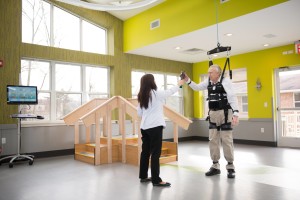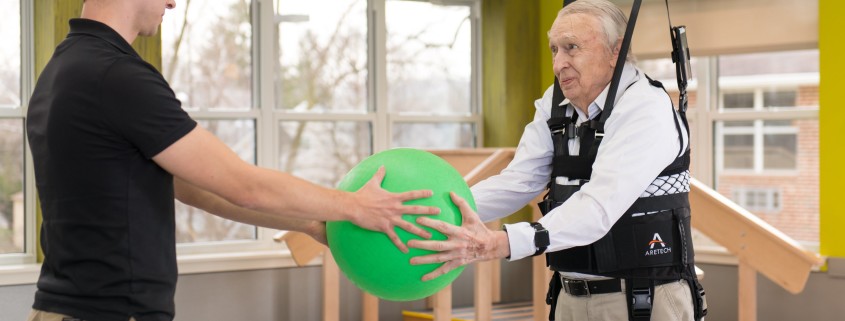Case Study: Faster Recovery Time with ZeroG
Source: Evergreen Health & Rehab
After two devastating falls, one that broke his back and another that broke his hip, Gerald Mott of Toms Brook, VA was basically unable to walk or perform many other necessary activities of daily living (ADLs). Mott, 74, also suffers from osteoporosis. Still, he was highly motivated to get back on his feet and return home after his injuries.
Faster Post-Surgery Rehabilitation
After orthopedic surgery, Mott was transferred from the hospital to Evergreen Health and Rehab, Winchester, VA, the only local rehab facility with a state-of-the-art rehabilitation device called the ZeroG Gait and Balance Training System, developed by Aretech. Mott was the first patient to use Evergreen’s ZeroG after the facility acquired it on July 1, 2015.
Dr. Michael Li, Evergreen’s Medical Director, said that the ZeroG Gait and Balance System is helping to lower overall rehabilitation costs. “With the help of the robotic ZeroG, patients can recover faster and more quickly regain function,” explained Li.
In the case of Mott, it’s estimated that the ZeroG cut his rehabilitation center stay in at least half. He spent just 5 weeks at Evergreen and now continues his physical therapy twice a week at the home he shares with his wife of 52 years. Evergreen’s Rehab Director, Connie Peace, said that Mott would have likely become a long-term care resident, or had a very lengthy stay of 10 weeks or more had he not been able to rehabilitate using the ZeroG.

About the ZeroG Gait and Balance Training System
The ZeroG robotic system allows patients to practice functional activities safely, with biofeedback that provides vital motivation and cues. The technology can compensate for a patient’s poor coordination or weakness while lowering the risk of injury to both the patient and the therapist. Besides helping patients rehab after orthopedic surgery, the ZeroG also has applications for patients who have had a stroke, spinal cord injury, traumatic brain injury, amputation, cerebral palsy or multiple sclerosis.
The ZeroG technology is used in about 77 of the leading rehab hospitals in the United States, according to Michael Ranberger, president and owner of Evergreen. “It’s pretty unusual for ZeroG to be in a post-acute facility like ours, but Evergreen does a lot of return-to-home rehab,” said Ranberger.
More Aggressive Therapy Speeds Progress
Mark Howard, Evergreen’s business development manager, pointed to another aspect of the ZeroG that helps speed up rehabilitation progress. “This device is really conducive to getting people up on their feet faster,” he said. Howard explained that, because patients are out of their walkers and wheelchairs, the therapists can use both hands and be much more aggressive in therapy. The more aggressive the therapy, the faster the progress.
Mott, for one, is extremely grateful for the positive outcome. “It’s going to help so many people,” he said. “I was excited to just be a part of it because I couldn’t move at all.”
“I went from the wheelchair to the walker,” Mott said. “[Now] I can use two canes to get around. I thought I would never walk again. You have to go to rehab. You have to.”





Leave a Reply
Want to join the discussion?Feel free to contribute!